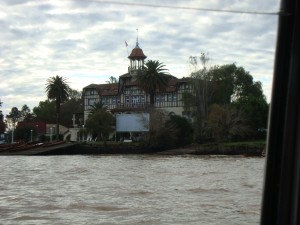Today we arrived in Buenos Aires! After a long plane ride with not too many setbacks, my group was picked up at the airport and driven to the hotel, NH Crillon Buenos Aires. The hotel feels relatively Americanized and it is right across from a large park and next to a pharmacy and a few restaurants. When I got to the hotel, I had about an hour to get myself settled until we got on our bus with our guide, Adriana, and drove to an Argentinian “street festival” by the Tigre River and Rio de la Plata. On the drive to the river, we went through Buenos Aires and Adriana pointed out many points of interest. I noticed that the city seemed very centered around art and sculptures and can’t wait to go get a closer look at them. We also drove by the law school, which is completely free for students!
When we got off the bus, we had about 40 minutes to buy food before our boat tour. My group found a cute little street shop where we got “choripan,” a type of sandwich with a sliced sausage and vegetables inside. We then made our way back onto the bus and towards the river. At the river, we boarded a boat and began sailing. Near the main boat center, there were a few large buildings backing up to the water and lots of palm trees. We also sailed past a roller coaster, Ferris wheel, and water park. One thing I found really interesting about the river was the color. Because the water comes from a waterfall, it contains a lot of sediment, so it is a light brown color. It almost looks like chocolate milk. Our boat started from an inlet and when you got to where the inlet met the river, you could actually see a line where the water went from normal-looking to brown.
As we made our way down the river, we saw many people (natives and tourists) enjoying it. There were many people on boats and kayaks. Farther down the river, there were a lot of houses with docks on the river. There are no roads that go to these houses, so the residents have to work their lives completely around the river. For example, there are schools and churches along the river that residents can get to by boat. They also have specific boats to bring them services, such as doctor boats, supermarket boats, and kiosk boats. One surprising thing about this lifestyle is that they do not have running water. Residents get their water from the river and purify it themselves and use it to bathe and for other reasons. However, they cannot drink this water. They must buy bottled water to drink and cook with. I also was surprised by the fact that many of these houses had dogs as pets and I saw hardly any strays.
When we got back to the hotel, we had time to get ready and then went to dinner at an Argentinian buffet. There were many foods that I had never seen before and a ton of meat. Everything was very good! My favorite thing that I ate was the fruit dipped in the chocolate fountain. After dinner, we walked back to the bus stop and made our way back to the hotel. From the hotel, a smaller group of us went and walked to a nearby Irish pub to try some Argentinian beer and talk to each other more. When we finished, we came back to the hotel for some much-needed sleep.






